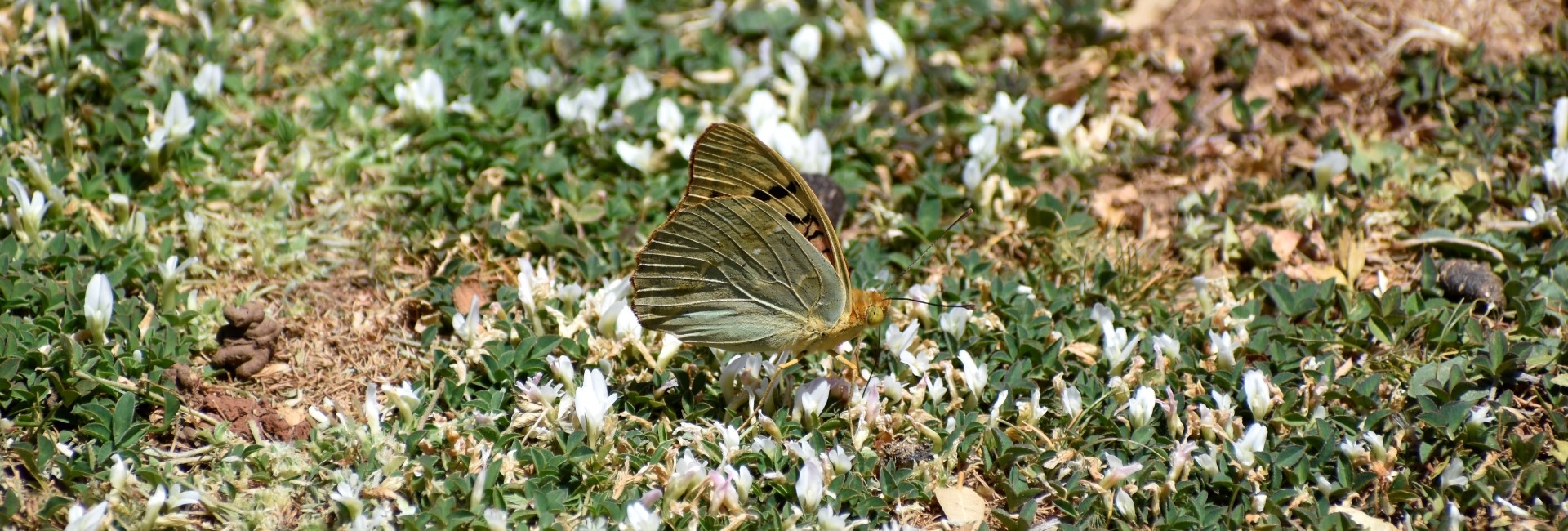
Argynnis pandora, Crete - photo © Ch. Almpantakis
Γλωσσάρι
Α
abdomen: the segmented tail area of an insect that contains vital organs
anal angle: the posterior corner of the wing
androconia: specialized scent-releasing scales of males
antenna: sensory appendages attached to the head of butterflies and moths
antenna club: the end of the antennae
apex: the anterior corner of a butterfly’s wing
aposematism: the use of warning coloration to inform potential predators that an animal is poisonous, venomous, or otherwise dangerous.
B
basal area: the area of a wing nearest the body, where it joins the thorax.
basking: known as reflectance and this is used when the butterfly wants to reflect the sunlight to their body versus just their wings. The butterfly sit or lie back lazily in warmth and light
C
cell: a closed area of an insect bounded by veins
chitin: polysaccharide compound that is a key constituent of the butterfly exoskeleton or cuticle
claw: the very tiny hooks on a butterfly’s feet
cocoon: a silk protective covering for pupa
compound eye: the eye of a butterfly or a moth, made up of numerous hexagonal lenses which focus light from each angle
costa: the anterior margin of the wing
cremaster: used to attach the hind end of a butterfly or moth’s pupa to a twig or other structure. The cremaster can be a series of small hooks or just a single larger hook.
crepuscular: appearing or active in twilight
D
dimorphism: having two forms, e.g. sexual dimorphism
discal area: the area between the basal and the postdiscal area on the wing
diurnal: active during the day
dorsal: upper part or topside
E
endemic: exclusively occurring in a defined geographic area
external margin: the outer part of the wing
F
food plant: a plant that provides food for the caterpillars
foreleg: the first pair of legs, attached to the prothorax
forewing: the upper wings of a butterfly attached to the mesothorax
fringes: the edging of fine even hairs on the wing of a butterfly
H
habitat: the natural home or environment of an organism
hibernation: a state of minimal activity and metabolic depression
hind legs: the last pair of legs, attached to the metathorax
hindwing: the upper wings of a butterfly attached to the metathorax
I
inner margin: the inner part of the wing
L
larva: the active immature form of a butterfly, the caterpillar
Lepidoptera: (=scaled wings) order of insects that comprises the butterflies and moths
loopers: larvae of the families Geometridae and Noctuidae that move with a looping motion in which the hind prolegs draw the posterior body toward the front followed by forward extension by the anterior legs.
M
migrant: a butterfly that seasonally moves (migrates) from one area to another
midleg: the middle pair of legs, attached to the mesothorax
mimicry: the superficial resemblance of two or more organisms that are not closely related taxonomically
miners: various insects, such as moths that in the larval stages burrow in and eat several parts of their host plant
myrmecophily: ecological relationships of organisms regularly associated with ants
N
nocturnal: active at night
O
ocellus (pl. ocelli): simple eyes bearing only one lens, generally adjacent to compound eyes; fake eyespots
ommatidium (pl. ommatidia): a single unit of a compound eye
osmeterium: a gland bearing strongly smelling substances, usually forked and everted typically from behind the head
P
palps: appendages of insect mouthparts
patrolling: fly over a particular area where other butterflies are active for the purpose of searching out a mate
perching: landing on a tall plant or other objects for the purpose of searching out a mate
plume: a long, soft feather or arrangement of feathers
polyphagous: feeding on many plant species
positive phototaxis: a locomotory movement, that occurs when an organism moves towards a stimulus of light, in the direction of increasing light intensity
postdiscal area: the area between the submarginal and discal area on the wing
prolegs: fleshy pairs of supplementary legs on larval abdominal segments
proboscis: an elongated feeding tube attached to the head of the butterfly
pupa: the ‘chrysalis’ or the third stage in the life cycle of a butterfly
S
submarginal area: the area of a wing usually furthest from the body
T
thorax: the body section between the head and the abdomen
V
ventral: lower part or underside
W
wingspan: the distance across the tops of a butterfly wings